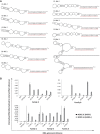Delivery of chemo-sensitizing siRNAs to HER2+-breast cancer cells using RNA aptamers
- PMID: 22467215
- PMCID: PMC3401474
- DOI: 10.1093/nar/gks294
Delivery of chemo-sensitizing siRNAs to HER2+-breast cancer cells using RNA aptamers
Abstract
Human epidermal growth factor receptor 2 (HER2) expression in breast cancer is associated with an aggressive phenotype and poor prognosis, making it an appealing therapeutic target. Trastuzumab, an HER2 antibody-based inhibitor, is currently the leading targeted treatment for HER2(+)-breast cancers. Unfortunately, many patients inevitably develop resistance to the therapy, highlighting the need for alternative targeted therapeutic options. In this study, we used a novel, cell-based selection approach for isolating 'cell-type specific', 'cell-internalizing RNA ligands (aptamers)' capable of delivering therapeutic small interfering RNAs (siRNAs) to HER2-expressing breast cancer cells. RNA aptamers with the greatest specificity and internalization potential were covalently linked to siRNAs targeting the anti-apoptotic gene, Bcl-2. We demonstrate that, when applied to cells, the HER2 aptamer-Bcl-2 siRNA conjugates selectively internalize into HER2(+)-cells and silence Bcl-2 gene expression. Importantly, Bcl-2 silencing sensitizes these cells to chemotherapy (cisplatin) suggesting a potential new therapeutic approach for treating breast cancers with HER2(+)-status. In summary, we describe a novel cell-based selection methodology that enables the identification of cell-internalizing RNA aptamers for targeting therapeutic siRNAs to HER2-expressing breast cancer cells. The future refinement of this technology may promote the widespread use of RNA-based reagents for targeted therapeutic applications.
Figures








Similar articles
-
Systemic Delivery of Aptamer-Conjugated XBP1 siRNA Nanoparticles for Efficient Suppression of HER2+ Breast Cancer.ACS Appl Mater Interfaces. 2020 Jul 22;12(29):32360-32371. doi: 10.1021/acsami.0c07353. Epub 2020 Jul 10. ACS Appl Mater Interfaces. 2020. PMID: 32613835
-
Synergistic Targeting HER2 and EGFR with Bivalent Aptamer-siRNA Chimera Efficiently Inhibits HER2-Positive Tumor Growth.Mol Pharm. 2018 Nov 5;15(11):4801-4813. doi: 10.1021/acs.molpharmaceut.8b00388. Epub 2018 Oct 1. Mol Pharm. 2018. PMID: 30222359 Free PMC article.
-
Anti-EGF Receptor Aptamer-Guided Co-Delivery of Anti-Cancer siRNAs and Quantum Dots for Theranostics of Triple-Negative Breast Cancer.Theranostics. 2019 Jan 25;9(3):837-852. doi: 10.7150/thno.30228. eCollection 2019. Theranostics. 2019. PMID: 30809312 Free PMC article.
-
[Advance in the study of targeting delivery system for siRNA mediated by aptamers].Yao Xue Xue Bao. 2012 Jul;47(7):850-5. Yao Xue Xue Bao. 2012. PMID: 22993847 Review. Chinese.
-
Strategies for siRNA navigation to desired cells.Methods Mol Biol. 2015;1218:201-16. doi: 10.1007/978-1-4939-1538-5_12. Methods Mol Biol. 2015. PMID: 25319653 Review.
Cited by
-
Recent advances in aptamer-based targeted drug delivery systems for cancer therapy.Front Bioeng Biotechnol. 2022 Aug 16;10:972933. doi: 10.3389/fbioe.2022.972933. eCollection 2022. Front Bioeng Biotechnol. 2022. PMID: 36051580 Free PMC article. Review.
-
Aptamers as Potential Therapeutic Tools for Ovarian Cancer: Advancements and Challenges.Cancers (Basel). 2023 Nov 6;15(21):5300. doi: 10.3390/cancers15215300. Cancers (Basel). 2023. PMID: 37958473 Free PMC article. Review.
-
Stable RNA nanoparticles as potential new generation drugs for cancer therapy.Adv Drug Deliv Rev. 2014 Feb;66:74-89. doi: 10.1016/j.addr.2013.11.006. Epub 2013 Nov 22. Adv Drug Deliv Rev. 2014. PMID: 24270010 Free PMC article. Review.
-
Development of an efficient targeted cell-SELEX procedure for DNA aptamer reagents.PLoS One. 2013 Aug 13;8(8):e71798. doi: 10.1371/journal.pone.0071798. eCollection 2013. PLoS One. 2013. PMID: 23967247 Free PMC article.
-
Aptamers Selected for Recognizing Amyloid β-Protein-A Case for Cautious Optimism.Int J Mol Sci. 2018 Feb 27;19(3):668. doi: 10.3390/ijms19030668. Int J Mol Sci. 2018. PMID: 29495486 Free PMC article. Review.
References
-
- Jemal A, Center MM, DeSantis C, Ward EM. Global patterns of cancer incidence and mortality rates and trends. Cancer Epidemiol. Biomarkers Prev. 2010;19:1893–1907. - PubMed
-
- Jemal A, Siegel R, Xu J, Ward E. Cancer statistics, 2010. CA Cancer J. Clin. 2010;60:277–300. - PubMed
-
- DeSantis C, Jemal A, Ward E, Thun MJ. Temporal trends in breast cancer mortality by state and race. Cancer Causes Control. 2008;19:537–545. - PubMed
Publication types
MeSH terms
Substances
Grants and funding
LinkOut - more resources
Full Text Sources
Other Literature Sources
Molecular Biology Databases
Research Materials
Miscellaneous

